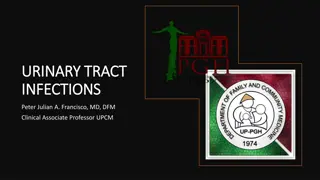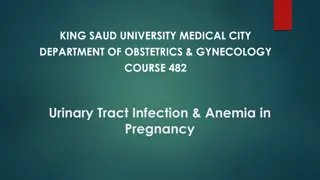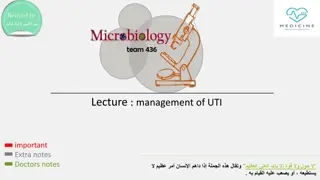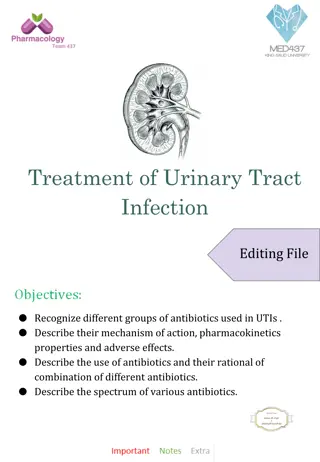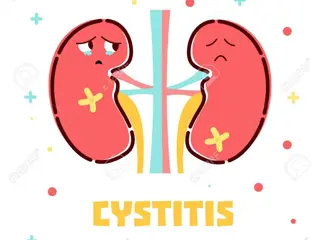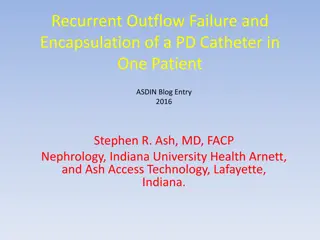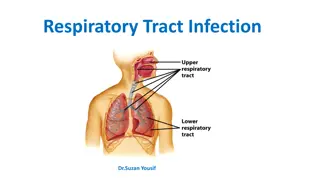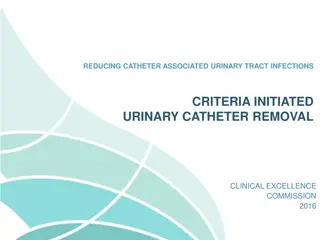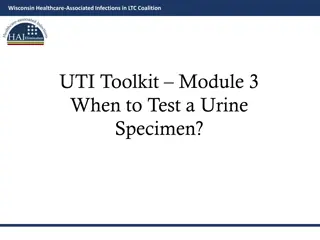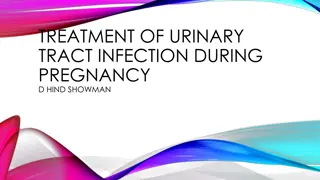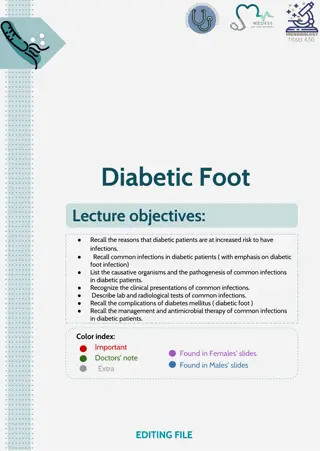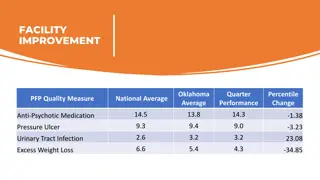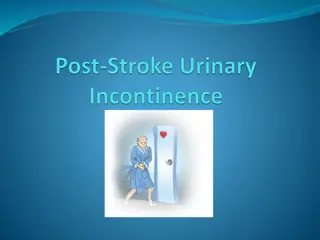Preventing Catheter-Associated Urinary Tract Infections
This presentation covers the prevention of catheter-associated urinary tract infections (CAUTIs) in healthcare settings. It highlights the significance of urinary tract infections, risk factors, preventive measures, and common microbiology involved. Key topics include the importance of urine collection, laboratory diagnosis, and understanding the bacteria commonly associated with CAUTIs. The information provided aims to reduce the incidence of these infections and promote patient safety.
Download Presentation

Please find below an Image/Link to download the presentation.
The content on the website is provided AS IS for your information and personal use only. It may not be sold, licensed, or shared on other websites without obtaining consent from the author. Download presentation by click this link. If you encounter any issues during the download, it is possible that the publisher has removed the file from their server.
E N D
Presentation Transcript
Prevention of Catheter-Associated Urinary Tract Infections
Learning objectives December 1, 2013 1. Describe the relevance of urinary tract infections in health care institutions. 2. Identify risk factors for urinary tract infections. 3. Describe measures for prevention. 2
Time involved December 1, 2013 50 minutes 3
Introduction December 1, 2013 Up to 40% of all HAIs Most involve urinary catheterisation Risk of bacteriuria 5% per day during the first week to almost 100% at 4 weeks of catheterisation 1 to 4% of patients with bacteriuria will develop infection 4
Urinary tract sites commonly associated with infection December 1, 2013 5
Urine December 1, 2013 Urine is an ultrafiltrate of blood, is normally sterile Small numbers of perineal/ vaginal/bowel microorganisms in the distal urethra Constantly washed out by micturition Bacteriuria = bacteria in the urine 6
Collection of urine December 1, 2013 Specimen contamination reduced by Cleaning external urethral area before collection Collecting mid-stream urines Urethral bacteria washed out in the first part of the stream Processing specimen promptly, or refrigerating, to prevent overgrowth of contaminants 7
Laboratory diagnosis December 1, 2013 Urine must be processed promptly Contaminants can multiply at room temperature and give falsely high colony counts If delay expected, transport the specimen in an ice box or add boric acid (1% W/V or 1 g/10 ml of urine) 8
Microbiology December 1, 2013 Usually endogenous microorganisms E. coli and Proteus commonest in community infections Catheter-associated UTI (CAUTI) E. coli commonest Increasingly caused by resistant species Klebsiella, Pseudomonas, Enterococcus and multiply drug resistant ESBL, VRE 9
Bacteria Causing UTIs (%) December 1, 2013 Organism Community Hospital E. coli Proteus Klebsiella Entero/Citro Pseudomonas Acinetobacter 80-90 5-8 1-2 45-55 10-12 15-20 2-5 10-15 < 1 Coag -ve staph Staph aureus Enterococci 1-2 1-2 < 1 10-12 < 1 10 10
Microbiological support December 1, 2013 The diagnosis of UTI depends on the microbiological support available In patients with indwelling catheters, infections frequently polymicrobial Presence of multiple bacteria does not necessarily indicate contamination 11 11
Quantitative bacteriology Small numbers of bacteria are insignificant True infections have large numbers in bladder urine Microbiology labs count the number of bacteria in a urine specimen as colony-forming units (cfu) Significant bacteriuria gives a >95% likelihood of true UTI 100,000 cfu/mL urine in 2 carefully-collected mid-stream urines (MSUs) December 1, 2013 12
Urethral bacteria contaminate specimens, small numbers December 1, 2013 -- Incubation Incubation -- - - - - Contamination Contamination - -- - - - 10 102 2- -10 103 3cfu/mL cfu/mL 13
Significant bacteriuria December 1, 2013 When large numbers of bacteria (>105/mL) in specimens of bladder urine & evidence of true UTI Smaller (insignificant) numbers may be due to contamination of the urine specimen during collection - urine has to pass through urethra Contamination can come from perineum/genitalia 14
True UTI with significant bacteriuria December 1, 2013 - - Natural Natural incubation incubation between between micturitions micturitions - - -- - -- - - - - - - - - -- - - - - - - - - - - - -- - - - - - - - - - - - - Infection Infection Infection -- - -- - -- - - - - -- - - -- - - - - - - >10 >105 5cfu/ cfu/mL mL 15 bacteria in bladder urine multiply to high numbers before collection
Quantitative microbiology distinguishes between true UTI & contamination or overgrowth December 1, 2013 103- 104 PROBABLE CONTAMINATION Mainly Mainly Gram+ves Gram+ves mixed species mixed species 900 Number of patients 800 104- 105 PROBABLE INFECTION 700 Mainly Gram Mainly Gram- -ves single species single species ves 600 500 400 300 200 NOT INFECTED NOT INFECTED INFECTED INFECTED 100 0 6 1 2 3 7 4 5 10 10 10 Bacteria/mL 10 10 10 10 16
Clinical diagnosis In non-catheterised patients: Fever, supra-pubic tenderness, frequency, dysuria Pyuria Positive nitrite reaction and a positive leukocyte esterase reaction In catheterised patients Fever and leukocytosis or leucopenia additional diagnostic criteria December 1, 2013 17
Definition and Surveillance December 1, 2013 Surveillance of CAUTI in selected patients e.g. intensive care or surgical Definition may be obtained: USA CDC/NHSN Centers for Disease Control and Prevention/ National Healthcare Safety Network HELICS Hospital in Europe for Link Infection Control through Surveillance 18
Pathogenesis of a Catheter- Associated UTI December 1, 2013 Normally urethral flora flushed out With catheterisation, flushing mechanism circumvented Flora can pass up through catheter or from drainage bag Hands of personnel may contaminate the system during insertion or management 19
Four main sites through which bacteria may reach the bladder in a catheterised patient December 1, 2013 from Damani N N, Keyes JK. Infection Control Manual, 2004 20
Principles to PreventUTI -1 December 1, 2013 Care bundle approach Evidence-based interventions When implemented together result in reduction in CAUTIs 21
Principles to PreventUTI -2 December 1, 2013 Staff training Training on procedures for insertion and maintenance of urinary catheters based on local written protocols Catheter size Smallest diameter catheter that allows free flow of urine 22
Principles to PreventUTI -3 December 1, 2013 Antimicrobial coated catheters Reduce asymptomatic bacteriuria For placement less than 1 week No evidence they decrease symptomatic infections Should not be used routinely Should be considered in selected high risk patients 23
Principles to PreventUTI -4 December 1, 2013 Catheter insertion and care Sterile equipment and aseptic technique Sterile lubricant or local anaesthetic gel Meatal cleansing with soap and water Antimicrobial ointment harmful Should be avoided 24
Principlesto PreventUTI -5 December 1, 2013 Drainage tubing and bag Secure to the patient Catheter drainage bag below the bladder Bag and tap not in contact with the floor Clamp drainage during movements Not disconnect the drainage bag Bag emptied when full Hand hygiene Alcohol impregnated swabs No disinfectant added to bag 25
Principles to PreventUTI -6 December 1, 2013 Specimen collection Samples from the port Aseptic technique Disinfection of port with alcohol Sterile needle, syringe, container Never a sample from the bag. No routine testing 26
Principles to PreventUTI -7 December 1, 2013 Antimicrobial agents Routine administration not recommended Single dose prophylactic may be used in selected patients No routine use while the catheter in situ Treatment may not be successful 27
PrinciplestoPreventUTI -8 December 1, 2013 Condom catheters May be used for short-term drainage Frequent changes Removed if irritation or skin breakdown Condom for 24 hour continuous use should be avoided 28
Key points December 1, 2013 Avoid urinary catheterisation not for incontinence consider intermittent catheterisation Remove catheters as soon as possible Aseptic technique and sterile equipment Don t change catheters routinely Closed drainage system No irrigation or instillation Empty drainage bag 29
References 1. APIC Elimination Guide: Guide to the Elimination of Catheter- Associated Urinary Tract Infections (CA-UTIs); Developing and applying facility-based prevention interventions in acute and long-term care settings, 2008. http://www.apic.org/Content/NavigationMenu/PracticeGuidance /APIC EliminationGuides/CAUTI_Guide.pdf HICPAC. Guidelines for prevention of Catheter-associated Urinary Tract infections 2009. Atlanta, GA: CDC, 2009. http://www.cdc.gov/hicpac/cauti/002_cauti_toc.html European and Asian guidelines on management and prevention of catheter-associated urinary tract infections. Intern J Antimicrobial Agents 2008: 31S; S68-S78. http://www.escmid.org/fileadmin/src/media/PDFs/4ESCMID_Lib rary/2Medical_Guidelines/other_guidelines/Euro_Asian_UTI_Gui delines_ISC.pdf December 1, 2013 2. 3. 30
References 4. SHEA /IDSA Practice Recommendation: Strategies to Prevent Catheter-Associated Urinary Tract Infections in Acute Care Hospitals. Infect Control Hospital Epidemiol 2008; 29 (Supplement 1): S 41-S50. http://www.jstor.org/stable/10.1086/591066 High Impact Intervention No 6. Urinary Catheter Care Bundle. London, Department of Health, 2007. http://www.dh.gov.uk/prod_consum_dh/groups/dh_digitalassets/@ dh/@en/documents/digitalasset/dh_078125.pdf UK Dept. of Health epic2: Guidelines for preventing infections associated with the use of short-term urethral catheters. J Hospital Infect 2007; 65S: S28-S33. http://www.vidyya.com/2pdfs/0124 infection.pdf December 1, 2013 5. 6. 31
References December 1, 2013 7. Infectious Diseases Society of America Guidelines. Diagnosis, Prevention, and Treatment of Catheter-Associated Urinary Tract Infection in Adults: 2009 International Clinical Practice Guidelines from the Infectious Diseases Society of America. Clin Infect Dis 2010; 50:625 663. http://www.idsociety.org/content.aspx?id=4430#uti 8. 32
Quiz 1. 2. Incontinence is an indication for urinary catheterisation. T/F? For a general strategy to prevent UTI, what measure you would consider first: a) Treatment of infected patients b) Avoid unnecessary catheterisation c) Replacement permanent catheterisation for intermittent d) Use of condom catheters Regarding prevention of UTI, which of the following is incorrect a) Keep system closed b) Hand hygiene before insertion/management of urinary devices c) Maintain catheter drainage bag below the bladder d) Use of antimicrobial prophylaxis in patients with urinary catheterisation December 1, 2013 3. 33
International Federation of Infection Control IFIC s mission is to facilitate international networking in order to improve the prevention and control of healthcare associated infections worldwide. It is an umbrella organisation of societies and associations of healthcare professionals in infection control and related fields across the globe . The goal of IFIC is to minimise the risk of infection within healthcare settings through development of a network of infection control organisations for communication, consensus building, education and sharing expertise. For more information go to http://theific.org/ December 1, 2013 34




